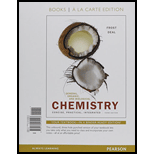
General, Organic, and Biological Chemistry, Books a la Carte Plus Mastering Chemistry with Pearson eText -- Access Card Package (3rd Edition)
3rd Edition
ISBN: 9780134183794
Author: Laura D. Frost, S. Todd Deal
Publisher: PEARSON
expand_more
expand_more
format_list_bulleted
Concept explainers
Question
Chapter 11, Problem 2IA.2Q
Summary Introduction
To determine:
The complementary DNA strand to the following strand:
Introduction:
There are two types of nitrogenous bases in DNA: purines and pyrimidines. Adenine and guanine are the purine bases that are double ring structures. Cytosine and thymine are the pyrimidines bases that have single ring structure.
Expert Solution & Answer
Want to see the full answer?
Check out a sample textbook solution
Chapter 11 Solutions
General, Organic, and Biological Chemistry, Books a la Carte Plus Mastering Chemistry with Pearson eText -- Access Card Package (3rd Edition)
Ch. 11 - Prob. 11.1PPCh. 11 - Prob. 11.2PPCh. 11 - Prob. 11.3PPCh. 11 - Prob. 11.4PPCh. 11 - Prob. 11.5PPCh. 11 - Which of the pentose sugars is found in DNA? Which...Ch. 11 - Prob. 11.7PPCh. 11 - Prob. 11.8PPCh. 11 - Prob. 11.9PPCh. 11 - Prob. 11.10PP
Ch. 11 - Prob. 11.11PPCh. 11 - Prob. 11.12PPCh. 11 - Draw the dinucleotide GC that would be found in...Ch. 11 - Prob. 11.14PPCh. 11 - Prob. 11.15PPCh. 11 - Prob. 11.16PPCh. 11 - Prob. 11.17PPCh. 11 - Prob. 11.18PPCh. 11 - Write the base sequence and label the 3 and 5 ends...Ch. 11 - Write the base sequence and label the 3 and 5 ends...Ch. 11 - Prob. 11.21PPCh. 11 - I jst the similarities and differences in the...Ch. 11 - Prob. 11.23PPCh. 11 - Prob. 11.24PPCh. 11 - Prob. 11.25PPCh. 11 - In your own words, define the term translation.Ch. 11 - Prob. 11.27PPCh. 11 - Prob. 11.28PPCh. 11 - Prob. 11.29PPCh. 11 - Prob. 11.30PPCh. 11 - Provide the three-letter amino-acid sequence...Ch. 11 - Provide the three-letter amino-acid sequence...Ch. 11 - Prob. 11.33PPCh. 11 - Prob. 11.34PPCh. 11 - The following portion of DNA is in the template...Ch. 11 - The following portion of DNA is in the template...Ch. 11 - Prob. 11.37PPCh. 11 - In your own words, define a silent mutation.Ch. 11 - Prob. 11.39PPCh. 11 - Consider the following portion of mRNA produced by...Ch. 11 - Prob. 11.41PPCh. 11 - Prob. 11.42PPCh. 11 - Why do viruses need to enter a host cell?Ch. 11 - Prob. 11.44PPCh. 11 - Prob. 11.45PPCh. 11 - It a virus contains viral RNA, a. name the first...Ch. 11 - Prob. 11.47PPCh. 11 - How do nucleoside analogs disrupt the life cycle...Ch. 11 - Prob. 11.49PPCh. 11 - Prob. 11.50PPCh. 11 - Prob. 11.51PPCh. 11 - Describe the structure of a plasmid.Ch. 11 - Prob. 11.53PPCh. 11 - Prob. 11.54PPCh. 11 - Prob. 11.55APCh. 11 - Prob. 11.56APCh. 11 - Prob. 11.57APCh. 11 - Prob. 11.58APCh. 11 - Prob. 11.59APCh. 11 - Prob. 11.60APCh. 11 - Prob. 11.61APCh. 11 - Write the complementary base sequence for each of...Ch. 11 - Prob. 11.63APCh. 11 - Prob. 11.64APCh. 11 - Prob. 11.65APCh. 11 - Prob. 11.66APCh. 11 - Prob. 11.67APCh. 11 - Prob. 11.68APCh. 11 - Prob. 11.69APCh. 11 - Prob. 11.70APCh. 11 - Prob. 11.71APCh. 11 - Endorphins arc polypeptides that reduce pain. What...Ch. 11 - What is the one-letter amino-acid sequence formed...Ch. 11 - Prob. 11.74APCh. 11 - What is the anticodon on tRNA for each of the...Ch. 11 - a. A base substitution changes a codon for an...Ch. 11 - Prob. 11.77APCh. 11 - Discuss whether or not each of the following is a...Ch. 11 - Prob. 11.79APCh. 11 - Prob. 11.80APCh. 11 - Prob. 11.81APCh. 11 - List two societal benefits to recombinant DNA...Ch. 11 - Prob. 11.83APCh. 11 - Oxytocin is a small peptide hormone involved in...Ch. 11 - Alpha-melanocyte stimulating hormone (o-MSH) is a...Ch. 11 - a. If the DNA chromosomes of salmon contain 28%...Ch. 11 - A protein aiumm 35 amino acids. How many...Ch. 11 - The DNA double helix can unwind or denature at...Ch. 11 - Prob. 1IA.1QCh. 11 - Prob. 1IA.2QCh. 11 - Prob. 1IA.3QCh. 11 - Prob. 1IA.4QCh. 11 - Prob. 1IA.5QCh. 11 - Prob. 1IA.6QCh. 11 - Prob. 1IA.7QCh. 11 - Prob. 1IA.8QCh. 11 - Prob. 1IA.9QCh. 11 - Prob. 2IA.1QCh. 11 - Prob. 2IA.2QCh. 11 - Prob. 2IA.3QCh. 11 - Prob. 3IA.1QCh. 11 - Prob. 3IA.2QCh. 11 - Prob. 3IA.3QCh. 11 - Prob. 3IA.4QCh. 11 - Prob. 3IA.5QCh. 11 - Prob. 3IA.6QCh. 11 - Prob. 3IA.7QCh. 11 - Prob. 3IA.8QCh. 11 - Prob. 3IA.9QCh. 11 - Prob. 3IA.10QCh. 11 - Prob. 1ICCh. 11 - Prob. 2ICCh. 11 - Prob. 3IC
Knowledge Booster
Learn more about
Need a deep-dive on the concept behind this application? Look no further. Learn more about this topic, chemistry and related others by exploring similar questions and additional content below.Nucleic acids - DNA and RNA structure; Author: MEDSimplified;https://www.youtube.com/watch?v=0lZRAShqft0;License: Standard YouTube License, CC-BY